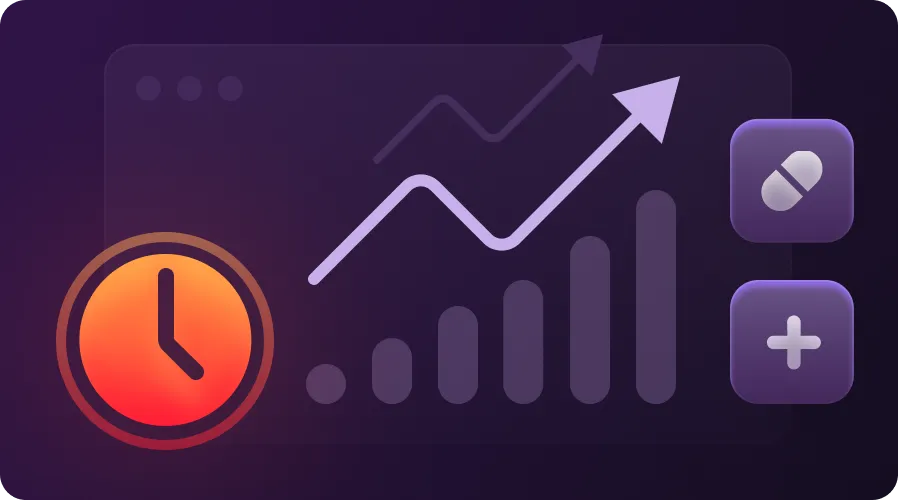Key UI/UX Principles for High-Performing Mobile Apps

There are about 8.93 million mobile apps worldwide, with new ones popping up daily, but not each of them has a good mobile interface design. At the same time, those who have it, win the hearts of customers and earn millions of dollars. So, how can you achieve this goal? Let’s find it out right now.
What Is Mobile App Design?
Mobile app design is the visual identity of an app tailored to the user's behavior. It has two components: UI and UX. UI (user interface) is how the application looks, and what colors, fonts, icons, buttons, or other elements it contains. UX is how an app works, responds to user actions, and helps fulfill people’s needs.
Interface design for a mobile application calls for consideration of the specifics of mobile platforms, such as screen size, data input methods, battery level, and internet connection speed. You should bear in mind that design can have a big impact on the success and popularity of the product, its usability, and its attraction to users.
Key Principles of Mobile App Design
Creating the interface of mobile applications is a truly complex and multi-layered process. It can vary dramatically depending on what project the app is created for, who the target audience is, and what functionality its owner is looking for. However, there are a few fundamentals to keep in mind when designing.
Here are top basic mobile design principles:
- Prioritize the user’s needs
- Focus on visual design
- Make the app interface convenient
- Make the content easy to read
- Add some interaction
- Optimize the interface for different mobile devices
User Interface (UI) Design Principles
Let’s define the most important user interface design principles.
Simplicity
An eye-catching and straightforward user interface is ideal. There shouldn't be too many interface elements that can confuse a user. Nobody wants to explore a new interface once an application is downloaded—instead, people just want to get what they need or have fun. All they seek is simple products that “just work”, that’s why, you have to prioritize the main parts for design and remove the unnecessary ones.
There is a simple rule of thumb: one main action per screen. Each screen you design in your application should support a single, genuinely important action for the user. This makes it easier to learn and use. One hundred clear screens are better than a single cluttered one.
Consistency
The interface has to be intuitive and easy to navigate. You can add a great feature or content, but if people can't find it, it doesn't matter. Mobile navigation should be consistent. To ensure navigation doesn’t require any explanation, you should use the right visual metaphors, and check that each navigation item leads to the appropriate place.
Feedback and Response Time
Feedback informs users whether they are doing the proper action or not. It can be audible (the ding of a new message notification), tactile (the vibrating signal for a new email or call while your phone is set to "silent"), or just visual. Feedback should be provided after each operation to show if it was successful.
Feedback can be useful in responding to problems in four areas:
- Locating: Where are you?
- Current Situation: What's happening? Is it still going on?
- Prospects: What comes next?
- Effects: What did you get?
Quick, insightful, and observable feedback is essential to let people know their actions were noticed. The link between the activity and its effect should be clear so that users understand what happened, and what to expect next. Feedback is supposed to optimize and complement the user's experience rather than complicate it.
User Experience (UX) Design Principles
Now, we propose to list the key UX design principles.
Usability
Usability measures how easy and convenient it is for the user to interact with the interface of an application. It depends on the ease of navigation, structure, content quality, text layout, mobile app design, and a bunch of technical features. This aspect affects users' time on an app, conversion rates, and customer loyalty.
Here are five components of usability:
- Learnability: how easy is it for people to perform basic tasks the first time?
- Productivity: how quickly can people complete tasks?
- Memorability: when people come back to an application after a time out, how easily can they recover their skills?
- Error recovery: how many errors do users make, how serious are they, and how easily can people fix them?
- Enjoyment: How engaging is it to use the app? Does it help people accomplish their tasks?
User-Centric Design
User-centered design is an approach that consistently identifies user needs and translates them into a product. The core value is to focus on what people are used to, on what is “easy” for them and meets their basic needs.
Figure out what users want from your mobile application. On a food delivery app, people want to see available propositions, and discounts, place an order, track a delivery, and that’s it. They don’t want to read the history of a local family restaurant and its owners—this information may be kept in subsections.
Accessibility
If you want people to use your app, make it easy to reach. First, make sure it’s available on all mobile platforms and devices. Secondly, remember about inclusivity while designing for mobile devices. Partially blind or colorblind people may also use your product. So, you should help them effortlessly use it by adding voice interaction, and alternative text for images and employing color-blind oriented templates. Additionally, let customers change the text size in the app to suit their visual requirements.
Best Practices in Mobile App Design
Creating an interface that is both attractive and user-friendly is a challenge and an art. To achieve a delicate balance between aesthetics and functionality, designers need to utilize best practices.
User Interface and Navigation
Navigation in a mobile application must be intuitive. Each button or link has to state its purpose clearly. All icons must be recognizable and standardized.
Mobile UX design's best practice for icons is to tag them with text. Tagged icons ensure that the purpose is conveyed quickly and easily. You can see this in the most popular apps like YouTube, Spotify, and TikTok.
Content Organization and Data Entry
When directing user attention across the application interface, use visual hierarchy. Distinguish important elements from less significant ones by varying size and spacing. Features that stand out attract attention, and clustering related items makes them easier to understand. For better readability and differentiation between titles, subheadings, and body content, designers should use the proper font sizes and styles.
As for good examples of great content organization, we’d like to pay attention to Airbnb, an illustration of minimalism and simplicity. People love it for its aesthetic graphic design, balanced font sizes and colors, and the absence of flashy elements or bright banners. Airbnb has also made booking real estate clear: users understand what they are paying for.
Input fields and forms are the basic parts of mobile apps and are also crucial in mobile design principles. Improving the total user experience requires making these elements efficient and usable. Make a user type as little as possible by utilizing default values and input masks. Give consumers immediate feedback on validation so they can fix mistakes quickly. To help users fill out forms correctly, provide them with informative error warnings and visual clues.
Usability and Accessibility
If you choose the right color palette, you can greatly improve the user experience. Remember about color blindness and test how your app looks to users with different types of color perception. Use contrasting colors for text and background to make content easy to read for anyone and anywhere. Add some extra explanations if needed.
For example, the choice of clothing color in an online store should have a text explanation to be understood by people with a violation of color perception. Also, consider how the interface will look on small screens.
Performance and Responsiveness
Take into account a diverse range of screen sizes and resolutions. Your design should be adaptive to ensure perfect display on any device. To check adaptability, test your design on a tablet, smartphone, and computer: this way you can adjust the display of elements in the interface and understand what and where to improve. Make sure the elements are not overlapping and are scaled correctly.
Platform Conformance
Research iOS and Android operating system guidelines. A guideline is a set of rules that determine how mobile apps are designed within an operating system. The iOS and Android systems have recognizable elements that users expect to see, so the guidelines help to create optimal UX and UI. Also, it will speed up the development process and reduce bugs.
Tools for Designing for Mobile Devices
As for the most popular tools designers use to implement solutions for mobile devices, we can consider the next four.
Figma
Figma is an application for all kinds of graphical works: from creating website layouts to developing mobile interfaces and prototyping. Its biggest advantage is an opportunity to work directly in a browser, allowing access to projects from any computer or platform. You don’t have to buy multiple licenses or install the software. Another plus of the application is the collaboration feature that allows simultaneous changes to the project design by several users without the need to upload files locally.
Adobe XD
XD is designed from scratch to meet the requirements of modern UX/UI design with many features not available in other graphic applications. It solves the main problem that competitors can't cope with: it provides interaction with non-static elements and allows you to implement thoughtful dynamics on the page. Adobe XD is ideal for vector UI design, wireframe modeling, implementing engagement with interactive elements, and prototyping.
Sketch
Sketch is a simple vector tool. Designers and front-end developers use it to create UX/UI components. Sketch is simple and easy to learn, has an intuitive interface, and offers cross-platform design tools. It has a preview feature to see how the project will look on different devices. It has many good plugins and resources, plus some useful functions for working in the cloud.
InVision
InVision is a versatile design tool that focuses on maximizing UX for apps. It can be used to create automatically customized interactive prototypes for different devices. InVision Studio has tools for working with vector drawing, interactive design, and built-in animation. The application can be installed on macOS and Windows.
Mobile Application Design Process
UI UX mobile app design is a complex process that requires a thorough approach to ensure it is visually appealing and compatible with various devices and operating systems. You also need to make sure it’s handy for both experienced users and newcomers and meets modern trends in app design. So, what are the stages of mobile design?
- Gathering data and design requirements. Research is a crucial part of the design effort, guiding the development of a product concept that accurately defines the market niche, functionality, monetization, and usage scenarios.
- Planning the architecture and navigation of the application. UX specialists create architecture based on application usage scenarios, ensuring navigation and consistency. This design stage is crucial for the end-user, as it directly affects the app's navigation and overall user experience.
- Development of prototypes. Mockups are created for prototyping a mobile application, allowing for easy modification and identification of best solutions. This process involves discussing the architecture with the team and client, and later involving a team of developers to evaluate the technical design.
- Testing the prototype. Interactive prototypes allow testing the app design to ensure it is suitable for the target audience, allowing for detailed feedback and understanding of user behavior patterns. This stage of development helps identify non-obvious patterns and improves the product's overall functionality.
- Final refinements and development. Next, the agreed prototype is handed over to designers to make the product more attractive, refine the styling, and improve small user interactions, taking into account the final UI of a product. The final design is passed to developers who do the technical part.
Get Some Inspiration with Our Case Studies
Below, we invite you to check out some of our projects where we have successfully implemented all the ideas described above:
- Booking beauty appointment platform
- Takeout food delivery app
- Social network
- Advertising placement system
- Vehicle rental mobile app
- Smart city mobile app
Conclusion
Creating an aesthetically pleasing design is not enough. You also need to make it user-friendly and inclusive, bearing in mind mobile device demands. Your target audience will be captivated and delighted by the appealing, highly engaging, and intuitive mobile applications if you carefully adhere to mobile app design principles and never stop learning from real-world examples of great mobile applications.
FAQ
Mobile app design is the visual identity and user experience of an app. It includes UI (how the app looks) and UX (how the app works and responds to user actions).
Good design enhances usability, attracts users, and can significantly impact the app’s success and popularity.
User-centric design focuses on identifying and meeting user needs, ensuring the app is intuitive and easy to use.
Use visual hierarchy to direct user attention, distinguish important elements, and maintain readability with proper font sizes and styles.
Connect with us
.webp)
We are a tech partner that delivers ingenious digital solutions, engineering and vertical services for industry leaders powered by vetted talents.




.webp)
